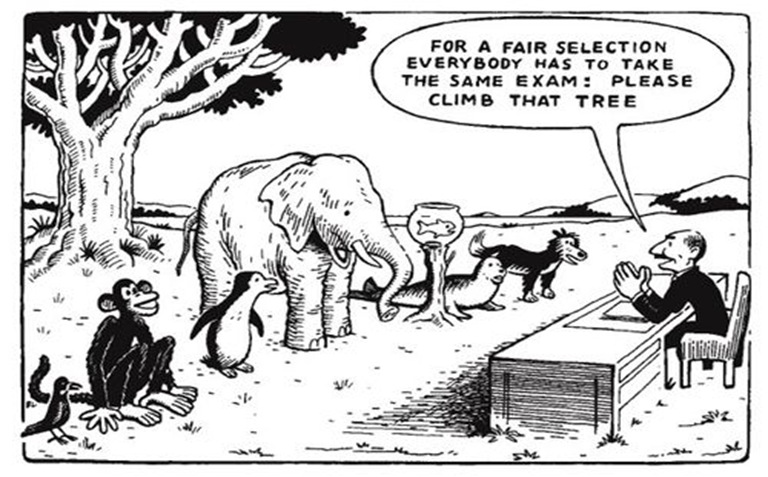Cultivating Mindsets: How Might We…
 Lauren Hobbs, Education Strategist, Dell EMC @laurhobbs
Lauren Hobbs, Education Strategist, Dell EMC @laurhobbs
Creativity isn’t something that is turned on and off like a light switch nor does it happen in a certain space during a scheduled “time”. With a shift to more learner centered experiences, providing the opportunity to create not only empowers students, but helps build the skills students need to thrive in our world today. Therefore, when defining success within the teaching and learning space we need to have a stronger focus on the process of learning. It is success throughout the learning process that truly creates meaningful opportunities for deeper understanding.
The chart above clearly depicts what can happen if we shift our thoughts toward learning environments that foster creativity. As a former educator and administrator in Pasco County, I had the opportunity to ask hundreds of Title I students “How do you learn the best?” Notice this question did not focus on the “what” but the “how” (the process) and two trends emerged; students identified their “how” with (1) peer collaboration and (2) opportunities to create.
Process Matters: How might we?
When we rethink the traditional processes and spaces through the lens of “How might we...” it shifts the problem-solving focus to searching for opportunities while empowering multiple modalities, perspectives, and resources to support making solutions visible.
Roles: How might we design learning experiences to empower students and teachers as co-creators?
Many times the conversation around creating is driven by the “stuff” and little focus is spent on how learning experiences will be facilitated. When teachers roles shift from being leaders of learning to co-creators in a student centered approach, the learning process success starts to look different. It is no longer about one answer, but rather the deeper learning that occurs when students are empowered to manipulate, ideate, and authentically process ideas in collaborations through contexts and mediums that connect to them personally. Being intentional in thinking through the roles of teachers and students as co-creators must be prioritized or “the stuff” will be just that, “stuff.” 
Authenticity: How might we foster student creativity to deepen learning through multiple mediums, multiple times per day with meaningful experiences?
Providing a balance of mediums that support both physical and digital dimensions will enable creative mindsets with voice and choice, but the flexibility of where/when/how students engage in these types of experiences need to be considered. If students only have access to mediums during certain times of the week or access is based on behavioral expectations, “making” could be viewed as just one more thing to do instead of the way to operationalize a culture of learning that engages and empower students.
Middle schoolers of Seminole County became not just problem solvers, but problem finders when they designed their own solution, “Spartan” (official branding coming soon) to support their teacher with day to day classroom tasks. Connecting to the role of smart technologies (such as Alexa, Siri, or Google home) in their lives, they empathized with the daunting task of attendance and the time it took away from learning. Exploring with multiple mediums (both physical and digital) to develop a deeper understanding of programming, these students learned how to purchase, design, program and personalize this solution to meet their teacher's needs. A true example of authenticity, not only connecting modalities and mediums, but also content.
Failing Forward: How might we cultivate cultures that support inquiry and creativity throughout the learning process as students make their thinking visible?
Although state tests are a driving metric for school success, how are we balancing these learning opportunities beyond memorization (“I choose C”) with the skills and dispositions students need to be successful in the workforce. Forbes magazine took the opportunity to identify the 12 qualities employers look for when they are hiring and not one of them referenced and the ability to recite content. Instead, employers are looking for applicants who are:
- self directed,
- know their strengths,
- are proactive,
- like to problem solve,
- and can think independently
This research indicates we need to rethink the design of learning experiences for success inside and outside of school.
Thinking Forward
Learning is no longer about which students hand went up the fastest, but instead the ongoing reflection and process in how we empower students to manipulate information and mediums to make their thinking visible. This past May I had the opportunity to support Marion County Schools with their Student Media Festival. The creativity in students as young as kindergarten developing storylines and manipulating different mediums using innovative technologies was incredible. However, during that event, one thing stood out; the love and excitement for learning. Isn’t that what our work is really about?
Students come to school with their “creative potential” ready to be cultivated, priming us with opportunities to foster conditions for inquiry and innovation among our classrooms. Why should learning experiences differ from how students interact with the world around them? While opportunities for authenticity can take many forms and come to life through a variety of perspectives consider the role creativity can play in the process and you may just be surprised in what you and your school communities can create. So, what are you going to create today?
Lauren Hobbs, Education Strategist, Dell EMC @laurhobbs
Lauren works with districts throughout the country as they design transformational models to support the future readiness of students. Passionate about student driven outcomes, design thinking, and rethinking the role of technology, she looks forward to continued work with leadership around the state.



Comments
Post a Comment